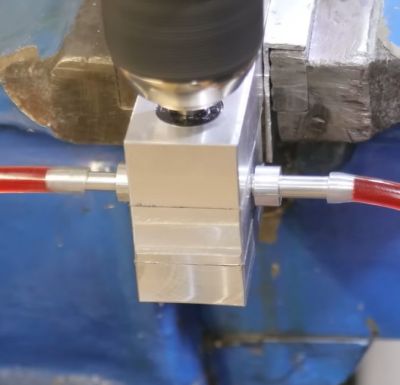Hackaday Links: October 26, 2025
-
Hackaday Links: October 26, 2025
There was a bit of a kerfuffle this week with the news that an airliner had been hit by space junk. The plane, a United Airlines 737, was operating at 36,000 feet on a flight between Denver and Los Angeles when the right windscreen was completely shattered by the impact, peppering the arm of one pilot with bits of glass. Luckily, the heavily reinforced laminated glass stayed intact, but the flight immediately diverted to Salt Lake City and landed safely with no further injuries. The “space junk” report apparently got started by the captain, who reported that they saw what hit them and that “it looked like space debris.”
We were a little skeptical of this initial assessment, mainly because the pilots and everyone aboard the flight were still alive, which we’d assume would be spectacularly untrue had the plane been hit by anything beyond the smallest bit of space junk. As it turns out, our suspicions were justified when Silicon Valley startup WindBorne Systems admitted that one of its high-altitude balloons hit the flight. The company, which uses HABs to gather weather data for paying customers, seems to have complied with all the pertinent regulations, like filing a NOTAM, so why the collision happened is a bit of a mystery.
Their blog post about the incident contains a clue, though, since they have made an immediate change to “minimize time spent between 30,000 and 40,000 feet,” which is the sweet spot for commercial aviation. They also state that future changes will allow them to monitor flight tracking data and autonomously avoid planes. From this, we gather that the balloons can at least control their altitude, which perhaps means this one somehow got stuck at 36,000 feet. We’d love to know more about these HABs; we wonder if there’s any way to track and recover these things like there is for radiosondes?
In other initially fake news, there was a bit of a stir in amateur radio circles with a report that Hytera ham radios were being banned from sale in the U.S. The report came in a video from Matt Covers Tech, and suggested that Hytera’s handy talkie radios had somehow fallen afoul of regulators. We did some checking around but couldn’t come up with anything to back up this claim until the indispensable Josh (KI6NAZ) over at Ham Radio Crash Course got ahold of the story and did his usual bang-up analysis. TL;DW — no, Hytera handy talkies are not being banned from sale in the U.S., but yes, the company does seem to be in a heap of trouble with the FCC and the federal government over some of their other shenanigans, to the point of felony indictments.
youtube.com/embed/RsX3JztCcLU?…
Back in the day, pranks were pretty simple and, with the possible exception of a burning poop-filled paper bag catching the bushes next to your front step on fire, mostly harmless. But pranks seem to scale with time and with technology, to the point where it’s now possible to stuff a dead-end street with 50 Waymos robotaxis. The stunt, which prankster Riley Walz describes in high-tech terms as “the world’s first Waymo DDoS” attack — we seriously doubt that — was carried out in a decidedly low-tech manner by enlisting 50 co-conspirators to simultaneously order a ride to San Francisco’s longest dead-end street. The Jaguar robotaxis dutifully reported to the address, packing the narrow street with waiting cars. Nobody got into the cars, resulting in a $5 missed-ride charge, but even if the riders did show up, we assume the autonomous cars would have had the robot equivalent of a stroke trying to figure out how to get out of each other’s way. Like most pranks, it was pretty cool as long as you weren’t the one on the receiving end. It’s not clear whether there were any repercussions for Riley — again, we doubt it — but we can imagine there would have been had anyone on that street needed fire or EMS while the attack was in progress.
If you’ve been worried about AI, you’re not alone. And while there’s plenty to be concerned about, according to Andy Masley, water use by AI data centers shouldn’t be one of them. In his excellent analysis, he looks at all the details of AI water use and comes to the convincing conclusion that, all things considered, U.S. data centers really don’t use that much water — about 0.2% of the 132 billion gallons consumed nationwide every day. Even then, that fraction of a percent includes the water needed to generate the electricity for those data centers; take that out, and the number drops to about 50 million gallons a day. And those figures are for all data centers; limited to just AI data centers, that number drops to about 0.008% of the freshwater consumed daily nationwide. We haven’t checked Andy’s math, of course, nor have we vetted his bona fides or checked to see if he has an axe to grind in this area. But it’s an eye-opening article nonetheless.
And finally, if you just can’t get enough of the surveillance state while you’re out in the world, you can now extend pervasive monitoring tech into the very heart of your home with the world’s first toilet wearable. The aptly named Throne One clips to the rim of your toilet and uses an array of sensors to monitor your gut health. The company doesn’t specify what sensors are used, but since the main data points seem to be where your poop falls on the Bristol Stool Scale and measuring hydration by urine color, there’s got to be a camera in there somewhere. There’s also allowance for multiple users, and while we suppose the polar opposite of facial recognition could be used to distinguish one butt from another, we’d imagine it would be simpler to determine who’s using the toilet via Bluetooth. There’s also a microphone, to listen in on “urinary dynamics” for those who pee standing up. Honestly, while we’d never actually use this thing, we’d love to do a teardown and see what’s inside. New in box only, of course.


